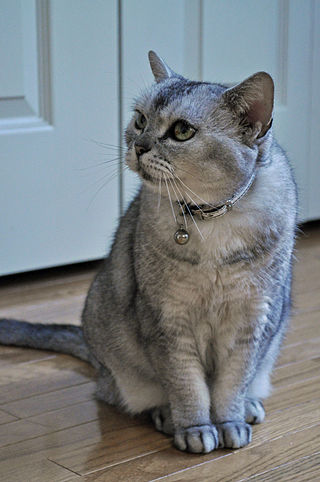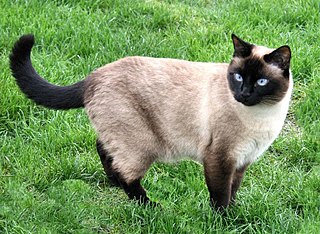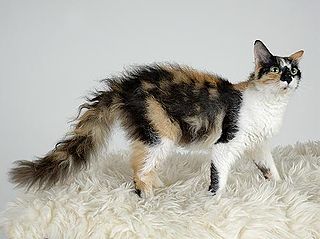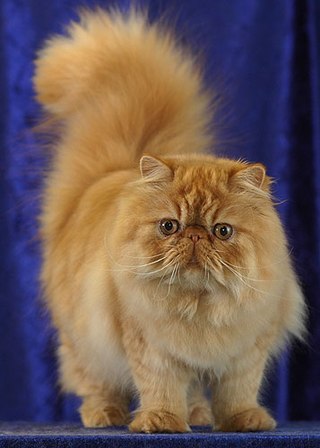
The British Shorthair is the pedigreed version of the traditional British domestic cat, with a distinctively stocky body, thick coat, and broad face. The most familiar colour variant is the "British Blue", with a solid grey-blue coat, pineapple eyes, and a medium-sized tail. The breed has also been developed in a wide range of other colours and patterns, including tabby and colourpoint.

The Maine Coon is a large domesticated cat breed. It is one of the oldest natural breeds in North America. The breed originated in the U.S. state of Maine, where it is the official state cat.

The American Curl is a breed of cat characterized by its unusual ears, which curl back from the face toward the center of the back of the skull. The breed originated in Lakewood, California, as the result of a spontaneous mutation.

The American Bobtail is an uncommon breed of domestic cat which was developed in the late 1960s. It is most notable for its stubby "bobbed" tail about one-third to one-half the length of a normal cat's tail. This is the result of a cat body type genetic mutation affecting the tail development, similar to that of a Manx cat. The breed is not related to the Japanese Bobtail despite the similar name and physical type—the breeding programs are entirely unrelated, and the genetic mutation causing the bobbed tail are known to be different because the mutation causing the American Bobtail's tail is dominant, whereas the Japanese Bobtail tail mutation is recessive.

The American Shorthair (ASH) is a breed of domestic cat believed to be descended from European cats brought to North America by early settlers to protect valuable cargo from mice and rats. According to the Cat Fanciers' Association, in 2020, it was the eighth most popular pedigreed cat in the world.

The Oriental Shorthair is a breed of domestic cat that is developed from and closely related to the Siamese cat. It maintains the modern Siamese head and body type but appears in a wide range of coat colors and patterns. Like the Siamese, Orientals have almond-shaped eyes, a triangular head shape, large ears, and an elongated, slender, and muscular body. Their personalities are also very similar. Orientals are social, intelligent, and many are rather vocal. They often remain playful into adulthood, with many enjoying playing fetch. Despite their slender appearance, they are athletic and can leap into high places. They prefer to live in pairs or groups and also seek human interaction. Unlike the breed's blue-eyed forebear, Orientals are usually green-eyed. The Oriental Longhair differs only with respect to coat length.

The Snowshoe is a breed of cat originating in the United States of America in the 1960s. Snowshoes were first produced in Philadelphia when a Siamese breeder's cat gave birth to three kittens with white feet. The breeder, Dorothy Hinds-Daugherty, then began a breeding program to produce what were originally called "Silver Laces", crossing the strangely marked Siamese cats with bi-color American Shorthair cats and other breeds. When Hinds-Daugherty left the program, Vikki Olander began working with the cats and recruited new breeders, as well as worked towards full recognition within cat associations. Despite having existed for 45 years, Snowshoes are rare due to the difficulty of reproducing the correct coat markings. The marks are based on recessive genes for color points and on the co-dominant but variably-expressed piebald pattern gene, making it difficult to predict the appearance of offspring.

The Chausie is a domestic breed of cat that was developed by breeding a few individuals from the non-domestic species jungle cat to a far greater number of domestic cats. The Chausie was first recognized as a domestic breed by The International Cat Association (TICA) in 1995. Within the domestic breeds, the Chausie is categorized as a non-domestic hybrid source breed. Because Chausies are mostly descended from domestic cats, by about the fourth generation they are fully fertile and completely domestic in temperament.

The Sokoke is natural breed of domestic cat, developed and standardised, beginning in the late 1970s, from the feral khadzonzo landrace of eastern, coastal Kenya. The Sokoke is recognized by four major cat pedigree registry organizations as a standardised cat breed. It is named after the Arabuko Sokoke National Forest, the environment from which the foundation stock was obtained, for breed development primarily in Denmark and the United States. The cat is long-legged, with short, coarse hair, and typically a tabby coat, though specific lineages have produced different appearances. Although once rumored to be a domestic × wildcat hybrid, genetic study has not borne out this belief. Another idea, that the variety is unusually ancient, remains unproven either way. The native population is closely related to an island-dwelling group, the Lamu cat, further north.

Point coloration is animal coat coloration with a pale body and relatively darker extremities, i.e. the face, ears, feet, tail, and scrotum. It is most recognized as the coloration of Siamese and related breeds of cat, but can be found in dogs, rabbits, rats, sheep, guinea pigs and horses as well.

The International Cat Association (TICA) is considered the world's largest genetic cat registry. Originally a North American organization, it now has a worldwide presence. The organization has a genetic registry for pedigreed and household pet cats and is one of the world's largest sanctioning bodies for cat shows.

Colorpoint Shorthair cat are a variety of domestic cats. Depending on the cat registry, they may be considered a separate breed of cat, or more often a variant of a pre-existing one, if accepted at all. These cats are distinguished by their conformance to wide range of sixteen different point colors, beyond the four standard Siamese colors. The variety was initially created by crossbreeding Siamese with the American Shorthair – the same mixture that created the Oriental Shorthair, but with different goals. The Colorpoint Shorthair shares the point-coloration pattern with the Siamese, but in the nontraditional colors of red, cream, tortoiseshell, and lynx (tabby) points, and minor variations thereof. In body style, head shape, and other features, it may be intermediate between the two foundation bread cats, which show cats leaning toward Siamese traits. Those who favour the Traditional Siamese look may also favour the more moderate-typed Colorpoint Shorthairs that take after their Shorthair ancestors in shape.

The Serengeti is a breed of domestic cat, first developed by crossing a Bengal and an Oriental Shorthair. Recognized and registered by The International Cat Association (TICA), no other first generation crosses can be registered as Serengeti. From the Bengal × Oriental cross came the first foundation Serengeti. Breeders then worked with the cat to produce a cat that resembles the breed profile set by TICA. Created by biologist Karen Sausman of Kingsmark Cattery in California in 1994, the breed is still in the development stages, but the ultimate aim is to produce a cat that looks similar to a serval, without using any recent wild cat blood. Serengetis are spotted cats, with long legs and very large, round tipped ears. They have a long neck which blends with the base of the skull without tapering. Males are generally slightly larger and heavier than females and can weigh between 10 and 15 lb ; females generally weigh between 8 and 12 lb. They are recognized by TICA in tabby, ebony silver, ebony smoke and solid black.

The toyger is a breed of domestic cat, the result of breeding domestic shorthaired tabbies to make them resemble a "toy tiger", as its striped coat is reminiscent of the tiger's. The breed's creator, Judy Sugden, has stated that the breed was developed in order to inspire people to care about the conservation of tigers in the wild. It was recognized for "registration only" by The International Cat Association in the early 2000s, and advanced through all requirements to be accepted as a full championship breed in 2012. There are about 20 breeders in the United States and another 15 or so in the rest of the world, as of 2012.

The LaPerm is a breed of cat. A LaPerm's fur is curly, with the tightest curls being on the throat and on the base of the ears. LaPerms come in many colors and patterns. LaPerms generally have a very affectionate personality.

The British Longhair is a medium-sized, semi-long-haired breed of domestic cat, originating in Great Britain.

The Abyssinian is a breed of domestic short-haired cat with a distinctive "ticked" tabby coat, in which individual hairs are banded with different colors. They are also known simply as Abys.

The Persian cat, also known as the Persian longhair, is a long-haired breed of cat characterized by a round face and short muzzle. The first documented ancestors of Persian cats might have been imported into Italy from Khorasan as early as around 1620, however this has not been proven. Instead there is stronger evidence for a longhaired cat breed being exported from Afghanistan and Iran from the 19th century onwards. Widely recognized by cat fancy since the late 19th century, Persian cats were first adopted by the British, and later by American breeders after World War II. Some cat fancier organizations' breed standards subsume the Himalayan and Exotic Shorthair as variants of this breed, while others generally treat them as separate breeds.
























